#common patas monkey
Explore tagged Tumblr posts
Text

Brehm's Tierleben. Written by Alfred Brehm. Illustration by Wilhelm Kuhnert. 1922 edition.
Internet Archive
#mammals#primates#monkeys#de brazza's monkey#mona monkey#lesser spot-nosed monkey#common patas monkey#hamlyn's monkey#diana monkey#moustached monkey#red-tailed monkey#golden monkey#wolf's mona monkey#Wilhelm Kuhnert
377 notes
·
View notes
Text

Common patas monkey (Erythrocebus patas)
This ground-dwelling monkey is found over a huge range of savanna in sub-Saharan Africa, from the west coast all the way to Ethiopia in the east. They are omnivores, eating mostly seeds, leaves, and gum. They are actually the fastest primates in the world, beating even the fastest humans at a top speed of 34 miles per hour (55km/hr).
#markhors-menagerie#primates#old world monkeys#monkeys#animal facts#fun facts#animals#biology#common patas monkey
19 notes
·
View notes
Text
De Brazza's monkey
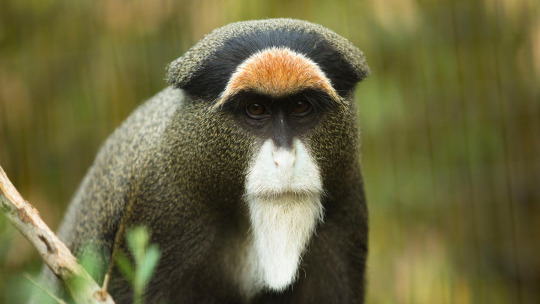
Sumatran orangutan
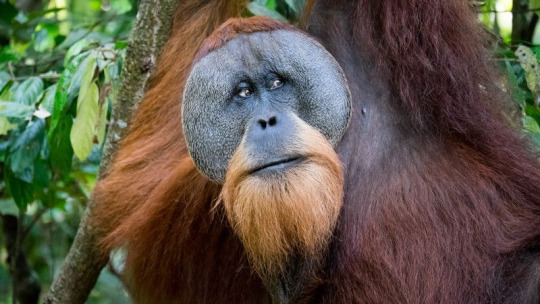
Mandrill

Emperor tamarin

Grey-shanked douc
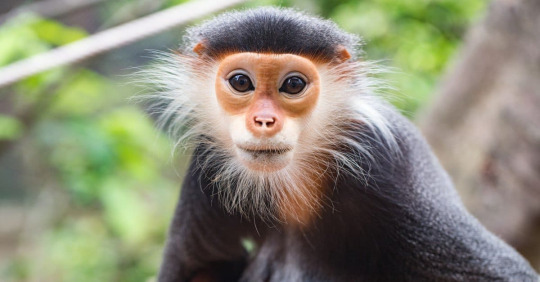
Lion-tailed macaque
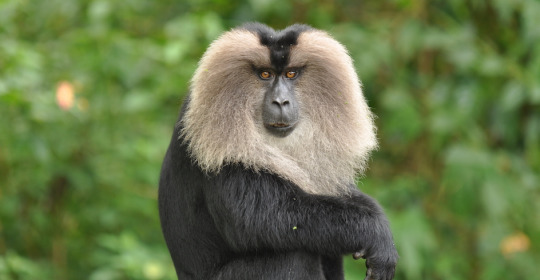
Lesser spot-nosed guenon
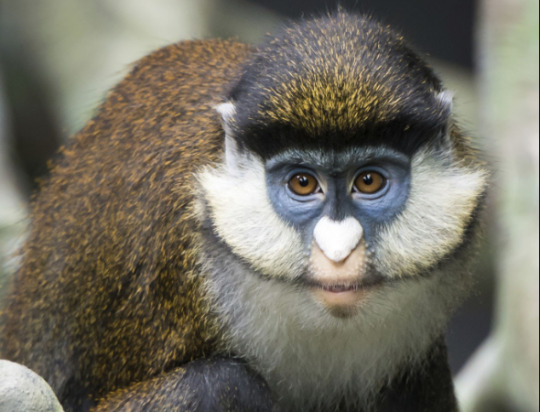
Moustached tamarin

White-faced saki

Agile gibbon

Common patas monkey
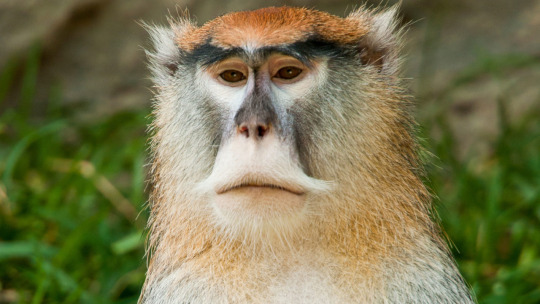
Roloway monkey

872 notes
·
View notes
Text
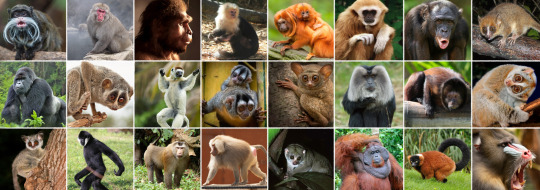
🦍The primate tournament list of candidates has been finalised! Polls will start going up soon!🦧
Thank you to everyone who submitted a species! Here is the full written list:
Basal primates (non-simian primates, including Strepsirrhini and Tarsiiformes)
†Notharctus (Notharctus tenebrosus)
Calabar angwantibo (Arctocebus calabarensis)
West African potto (Perodicticus potto)
Red slender loris (Loris tardigradus)
Bengal slow loris (Nycticebus bengalensis)
Pygmy slow loris (Xanthonycticebus pygmaeus)
Senegal bushbaby (Galago senegalensis)
Brown greater galago (Otolemur crassicaudatus)
Ring-tailed lemur (Lemur catta)
Verreaux’s sifaka (Propithecus verreauxi)
†Archaeoindris (Archaeoindris fontoynontii)
†Megaladapis (Megaladapis madagascariensis)
Madame berthe’s mouse lemur (Microcebus berthae)
Aye-aye (Daubentonia madagascariensis)
Philippine tarsier (Carlito syrichta)
Pygmy tarsier (Tarsius pumilus)
New world monkeys (Platyrrhini)
Wied’s marmoset (Callithrix kuhlii)
Goeldi’s marmoset (Callimico goeldii)
Bearded emperor tamarin (Saguinus imperator subgrisescens)
Golden-headed lion tamarin (Leontopithecus chrysomelas)
Panamanian white-faced capuchin (Cebus imitator)
Central American squirrel monkey (Saimiri oerstedii)
Gray-bellied night monkey (Aotus lemurinus)
Bald uakari (Cacajao calvus)
Madidi titi monkey (Plecturocebus aureipalatii)
Atlantic titi monkey (Callicebus personatus)
Black bearded saki (Chiropotes satanas)
White-faced saki (Pithecia pithecia)
Colombian red howler (Alouatta seniculus)
Brown spider monkey (Ateles hybridus)
Northern muriqui (Brachyteles hypoxanthus)
Yellow-tailed woolly monkey (Lagothrix flavicauda)
Old world monkeys (Cercopithecidae)
Mantled guereza (Colobus guereza)
Zanzibar red colobus (Piliocolobus kirkii)
Nepal gray langur (Semnopithecus schistaceus)
Silvery lutung (Trachypithecus cristatux)
Golden snub-nosed monkey (Rhinopithecus roxellana)
Proboscis monkey (Nasalis larvatus)
Red-shanked douc (Pygathrix nemaeus)
Collared mangabey (Cercocebus torquatus)
Japanese macaque (Macaca fuscata)
Rhesus macaque (Macaca mulatta)
Hamadryas baboon (Papio hamadryas)
Mandrill (Mandrillus sphinx)
Gelada (Theropithecus gelada)
Common patas monkey (Erythrocebus patas)
Bale mountains vervet (Chlorocebus djamdjamensis)
De brazza’s monkey (Cercopithecus neglectus)
Apes (Hominoidea)
Lar gibbon (Hylobates lar)
Pileated gibbon (Hylobates pileatus)
Kloss’s gibbon (Hylobates klossii)
Northern white-cheeked gibbon (Nomascus leucogenys)
Siamang (symphalangus syndactylus)
†Junzi (Junzi imperialis)
Bornean orangutan (Pongo pygmaeus)
†Gigantopithecus (Gigantopithecus blacki)
†Dryopithecus (Dryopithecus fontani)
Western lowland gorilla (Gorilla gorilla gorilla)
Chimpanzee (Pan troglodytes)
Bonobo (Pan paniscus)
†Australopithecus (Australopithecus afarensis)
†Panranthropus (Panranthropus boisei)
†Flores hobbit (Homo floresiensis)
†Neanderthal (Homo neanderthalensis)

The first set of polls will go up as soon as I have finished writing the descriptions! In the meantime, I would appreciate if you could share this tournament around- it won’t be much of a tournament if there aren’t that many people voting! In going down the research rabbit hole I’ve found so many interesting species and stories, and I promise learning about them here will be worth your time!
#primate bracket#tournament#tumblr tournament#poll#polls#primate#primates#extinct primates#biology#animals#zoology#please let me know if I made a mistake anywhere!
99 notes
·
View notes
Text
1: therian + weird feelings abt prehistoric humans
2: lion therian, and a very strong kinship towards paleolithic peoples (including other species of humans and also other primates) that is much stronger than what i feel towards modern people
3: i get lion shifts a lot, mostly paws, muzzle/teeth, tail, and claws, and i get mental shifts fairly frequently as well, most often when im eating certain foods that trigger it or if i just have strong enough emotions. dream shifts are very common. i occasionally get random primate shifts but not nearly as much as i used to when i was studying primatology in uni and "around" them more. i do still have shifts of my own fictional primate species (essentially a bipedal cercopithecine, mostly based on patas monkeys and macaques), which i think is my brain trying to reconcile a lion/human shape at the same time. i have two cameo shifts that show up in differing situations (a domestic dog and.. some kind of horned ungulate. the dog rarely visits anymore and is only there when im in crowds, and the ungulate guy shows up when im annoyed or doing certain physical labor), but my weirdest one was a pig! only happened once and it was very interesting.
4: for the lion, mostly through shifts and impulses. when i envision myself im just a lion, or an anthropomorphic one. im just an animal living my life, no different and no more special than any other. its just kind of a feeling always in the back of my mind.
5: i really only lurk, so i don't have many opinions lol. i'd like to eventually get more involved tho!
6: recognizing that really, i am just an animal. i have a relationship and kinship with everything alive, evolutionarily speaking, and that i am a unique but also not-unique organism in different ways. seeing a female chimpanzee or lioness or paleolithic human and thinking "you're no different than me, that could've been me, maybe should have been me". on a less introspective level, letting myself indulge in certain behaviors like eating meat off the bone and playing with my dogs like a big cat lmao. also, despite being a lioness i do love that my thick hair feels like a mane lol. i also like making art, food, or everyday items that my human ancestors would have made, as authentically as i can.
7: unfortunately yes, but its usually mostly just a strong frustration. i get particularly frustrated at not being able to move quadrupedaly, and not having claws or teeth the correct shape. i used to hate running as a child because it made me so upset not being able to run on all fours, the urge is SO ridiculously strong when im running.
8: don't be like me and deny and beat yourself up about it for years, just let yourself feel whatever you feel! but also be careful to protect yourself and your identity online, there's some weirdos out there yknow
9: technically no, i did make myself some paws with semi retractable claws but theyre an enormous pain to put on so i don't wear them unless theyre part of the full costume i made them for. a tail would be nice, i have one but i need to modify it for it to really scratch that "this is MY tail" itch. and not sure if it counts, but i do plan on getting some paleolithic inspired tattoos at some point.
10: honestly no idea, this could be anything lmao. i bounce between it being psychological and spiritual for various reasons like, daily, and it truly does not matter to me in the end, it is what it is.
11: don't really know anyone so, if you see this and want to do it then go for it!
If you are a alterhuman, reblog and answer these questions!
(don't be afraid to write a lot, do what you want ¯\_(ツ)_/¯)
1/ Which category of alterhumanity do you belong to?
2/ What/who is/are your type(s)? (if you have any)
3/ Do you experience shifts? If so, can you tell us your most common shifts and your strangest cameo shift (if you've ever had a cameo shift)?
4/ How do you experience your alterhumanity in everyday life?
5/ What do you think of the community?
6/ What are the things that make you most comfortable and euphoric in your alterhumanity?
7/ Are you experiencing species dysphoria?
8/ What advice would you like to say to a young alterhuman who has just awakened?
9/ Do you have/want to have gears?
10/ Do you know/have any theories about the origin of your alterhumanity? If so, tell us! (all beliefs are legitimate)
11/ Tag someone/a creature to answer these questions!ㅤᵕ̈
1K notes
·
View notes
Note
this might be too broad to be answerable, but is there any universal non-human primate body language for feeling good? i guess in general a relaxed demeanor would probably be positive, but since theyre all so closely related are there any other signs in common? (now that im thinking about it, theres no reason this wouldnt also include humans, because we arent inherently more removed from our cousins, but you get what im talking about haha)
There are over 500 species of primate and so the behaviors of one animal means one thing, it doesn't apply to all. For example, yawning. For a patas, yawning is a direct threat. For a macaque, yawning is in attempt to communicate a potential threat or tension. For a squirrel monkey, yawning has no specific communication purpose. Additionally, lemurs are seen yawning after a stressful event. Something as seemingly simple as a yawn has multiple uses and interpretation across the primate world!
Drawing comparisons over such a wide field as non-human primates is daunting. The only thing I can think of to be a chill behavior across the board would be sunbathing, and maybe allo-grooming (mutual grooming). A stressed, aggressive or distressed animal would not lounge in the sun or groom their friend.
For the most part!
Sometimes grooming is in an effort to sooth over tension after a display or chase. The defending monkey may groom the aggressor to solidify a bond and their respective ranks, therefore preventing future tension. This is most commonly seen in macaques and chimpanzees and other species with very strict hierarchies.
And nocturnal primates aren't going to be out sunbathing as a relaxing experience so I would go as far to say there may be no universal behavior for all non-human primates.
46 notes
·
View notes
Note
You've talked before about why human contact with apes/primates is generally ill-advised due to the transfer of diseases. Does this mean you've never been in he same enclosure as a primate?
lemurs i have been in the same enclosure as because they’re generally less dangerous and there’s less disease transfer between us and them but general rule of thumb you wanna wear a mask around primates even without the covid pandemic. other than lemurs and maybe like small patas monkeys i don’t really go INSIDE very many monkey enclosures in general unless like there’s some level of trust established between us first because even the cute small ones can and will hurt you if they feel threatened. but again masks and limited physical contact are generally encouraged because the common cold can and will kill
150 notes
·
View notes
Photo

Common patas monkey Patas . . #insta #instagood #instagram #instagramers #instaphoto #instadaily #instamoment #picoftheday #photo #photooftheday #photography #photographer #travel #travelphotography #travelblogger #travelgram #love #beautiful #happy #likeforlikes #likeforfollow #like4likes #film #landscape #tourism #animals (à Thoiry ZooSafari) https://www.instagram.com/p/CjhwWGgMBpq/?igshid=NGJjMDIxMWI=
#insta#instagood#instagram#instagramers#instaphoto#instadaily#instamoment#picoftheday#photo#photooftheday#photography#photographer#travel#travelphotography#travelblogger#travelgram#love#beautiful#happy#likeforlikes#likeforfollow#like4likes#film#landscape#tourism#animals
1 note
·
View note
Photo

Inspiration for Dr. Seuss's 'The Lorax' may be from real plant and animal life in Kenya
(via Science Daily, 7/23/18)
Ever since "The Lorax" by Dr. Seuss (the pen name for Theodor Geisel), was first published in August of 1971, it has captured the minds of young readers. It's been translated into 15 languages and more than 1.6 million copies were sold by 2010. The short and spunky, furry orange creature called the Lorax, who "speaks for the trees," is famous for his environmental pleas, as he demands that the Once-ler stop cutting down the Truffula trees to make yarn for the Thneeds. (...) Historical records indicate that Geisel wrote 90 percent of "The Lorax" while visiting Mount Kenya Safari Club in September 1970. That was the year that the U.S. environmental movement was born with the creation of the National Environmental Protection Act, Earth Day and the Environmental Protection Agency.
The illustrations of "The Lorax" provide important clues. For example, the spiky, barren trees outside the Once-ler's home look like the whistling thorn acacia (Acacia drepanolobium), a common tree found on the Laikipia plateau in Kenya. If Geisel noticed these trees while he was there, then he probably also saw patas monkeys (Erythrocebus patas), which rely on the acacia tree for more than three-fourths of their diet. The acacia tree and the patas monkey have a commensal relationship in which neither species is harmed. It is this very notion of commensalism that grounds the story of "The Lorax," according to the research team."
The proposal that the patas monkey might be the real-life referent for Dr. Seuss's Lorax introduces an interpretation of the children's tale that undermines the core assumption of human exceptionalism. If we really want this biodiverse planet to thrive, we cannot consider ourselves as separate from the environment. This is the deep message of the Lorax: He is a part of the ecological system not apart from it," explains co-author Donald E. Pease, a professor of English and the Ted and Helen Geisel Third Century Professor in the Humanities at Dartmouth. Pease is an expert on Theodor Geisel and author of "Theodor Seuss Geisel" (Oxford University Press, 2010).
"If the Lorax is genuinely part of the environment, he is modeling the attitude we need to assume," adds Pease.
(continue reading)
#Ethology#Primatology#Dr. Seuss#Biology#Zoology#my favourite book#my favourite monkey#because patas monkeys#my first primate study was on patas and acacia gum#so this little essay just brings joy to my heart#commensalism
8 notes
·
View notes
Text
Dr. Seuss might have written the Lorax after seeing these creatures in Kenya
New Post has been published on https://nexcraft.co/dr-seuss-might-have-written-the-lorax-after-seeing-these-creatures-in-kenya/
Dr. Seuss might have written the Lorax after seeing these creatures in Kenya
He is the Lorax. He speaks for the truffula trees. His origins are never explicitly addressed in the illustrated children’s book that bears his name, but new research reports that his tubby poise was inspired by a real animal—the patas monkey—and the monkey’s bond with a real tree, the whistling thorn acacia. In fact, the research argues, it may have even been their close relationship that got Theodor Seuss Geisel, known to generations of children as Dr. Seuss, to write it.
The story of this research begins at a Dartmouth College faculty dinner, where evolutionary biologist Nathaniel Dominiy ended up sitting with renowned Seuss expert Don Pease. The biologist says he was at a bit of a loss for what to talk about, but thankfully, “I have two kids… and so I’m pretty familiar with Dr. Seuss’s work.” One thing he’d noticed in the course of his fieldwork in Kenya: a monkey found near Mount Kenya, the patas monkey, bore a strong resemblance to the fictional Lorax. What Dominiy didn’t know was that Dr. Seuss had once visited a resort in that part of Kenya—in fact, he actually wrote most of the Lorax there after suffering from a prolonged bout of writer’s’ block.
Initially, says Pease, he was skeptical of the idea that the monkey may have inspired Seuss. By late 1970, when Seuss started writing The Lorax, he’d been creating illustrated books full of fantastical characters and absurd made-up words for more than three decades. He had plenty of wondrous characters to draw from, and there was no reason to think he’d look elsewhere.
“But then, I thought about what it might add to the established understanding of the Lorax,” Pease said. A common perception of the Lorax is as a grouchy environmental crusader or “eco-policeman” who comes in from outside to “speak for” an environment in which he has no stake.
But if the Lorax’s relationship with the truffula trees mirrored that of the patas monkeys and the tree from which they derive more than 80 percent of their food, he was both an advocate for the environment and as much part of it as the Bar-ba-loots, Swanee-Swans and Humming-Fish who rely on the truffula ecosystem. Then the message becomes, “Human beings should understand themselves as a part of the environment,” Pease says. After all, as climate change fundamentally alters our planet, we’re all in the same straits as the Lorax and his fellow creatures.
Pease and Dominiy embarked on a quest to assess whether the patas monkey may have inspired Seuss, using facial analysis. They compared the Lorax’s whiskery mug to five Kenyan monkeys and another Seuss creature commonly cited as an antecedent. The method they used, Eigenface analysis, compares images by looking for facial features and calculating their relationship to one another. Faces with more similar relationships look more similar to one another. In this case, they found that the Lorax’s face is more like those of three of the monkeys, including the patas monkey, than that of the other Seuss creature. Furthermore, the researchers write, “even the voice of the Lorax (a ‘sawdusty sneeze’) resembles the ‘whoo-wherr’ vocalization of patas monkeys.”
“We also know that he was very impressed by the local trees,” says Dominiy. The patas monkeys and the whistling thorns have what’s known as a commensal relationship, where the monkeys prune and maintain the trees, which provide their main sources of food. Because of these attentions, they have an odd, scrubby, tall appearance.
In 1971, when The Lorax was first published, the modern American environmental movement was still in its infancy. What Seuss wrote down, teaching generations of children, was the basis of what’s known as a “trophic cascade,” says Dominiy. In other words: “When you remove a piece of the community, the rest of that community starts to fall apart.” These might seem like obvious concepts today, but at the time, they weren’t understood outside academia, he says. Seuss helped to change that.
Although these things may have inspired Seuss, patas monkeys and whistling acacias have not yet suffered the dismal fate of the truffulas and the creatures who relied on them, says primate ecologist Lynne Isbell. Isbell, who was not involved with this paper, has worked extensively with patas monkeys in the past. The monkeys aren’t yet endangered, she says, but their ecosystem is not as stable as it once was. The monkeys are losing food and habitat as the human population expands into a landscape that can’t even support the current level of human incursion. In this case, a major factor are local people, who rely on charcoal made from the acacia, cutting the trees down to make fuel.
“Unless people can find some better fuel source… I don’t see much hope for [the patas monkeys],” she says. And, just like the character they inspired, the monkeys don’t control the fate of the trees. The conservation of this habitat can only come at the behest of the people who live there. In other words; Unless someone like you cares a whole awful lot, nothing is going to get better. It’s not.
Written By Kat Eschner
2 notes
·
View notes
Text
QOTD - reference
Pre-season 13
The best journeys answer questions that in the beginning you didn’t even think to ask – Jeff Johnson
Forget what we became, what matters is what we’ve become, and our potentials to overcome - Aniekee Tochukwu Ezekiel
Destiny is no matter of chance. It is a matter of choice. It is not a thing to be waited for, it is a thing to be achieved – WJ Bryan
New beginnings are often disguised as painful endings – Lao Tzu
To avoid criticism do nothing, say nothing, be nothing – Elbert Hubbard
Anger: an acid that can do more harm to the vessel in which it is stored than to anything on which it is poured – Mark Twain
Education is the kindling of a flame not the filling of a vessel - Socrates
Trust yourself. Think for yourself. Act for yourself. Speak for yourself. Be yourself. Imitation is suicide – Marva Collins
13.01 - Lost & Found
The bitterest tears shed over graves are for words left unsaid and deeds left undone – Harriet Beacher Stowe
Do not fear death so much, but rather the inadequate life – Bertolt Brechy
Democracy is a device that insures we shall be governed no better than we deserve – George Bernard Shaw
Every new beginning comes from some other beginning’s end – Seneca
We must travel in the direction of our fear – John Berryman
Neither should a ship rely on one small anchor, nor should life rest on a single hope – Epictetus
A traveler is really not someone who crosses ground so much as someone who is always hungry for the next challenge and adventure – Pico Iyer
13.02 - The Rising Son
Cease endlessly striving for what you want to do and learn to love what must be done – Johann Wolfgang von Goethe
The most authentic endings are the ones which are already revolving towards another beginning – Sam Shepard
If you want to shine like a sun, first burn like a sun – APJ Abdul Kalan
History is a vast early warning system – Norman Cousins
I don’t like to commit myself about heaven and hell. You see, I have friends in both places – Mark Twain
To succeed in life you need three things: a wishbone, a backbone and a funny bone – Reba McEntire
13.03 - Patience
Age does not protect you from love. But love, to some extent, protects you from age – Jeanne Moreau
Don’t be pushed by your problems. Be led by your dreams – Ralph Waldo Emerson
It isn’t the mountains ahead to climb that wears you out, it’s the pebble in your shoe – Mohammed Ali
Cowards die many times before their deaths; the valiant never taste death but once – William Shakespeare
Indifference and neglect often do more damage than outright dislike – JK Rowling
Too many people know the price of everything and the value of nothing – Oscar Wilde
Life should not be a journey to the grave with the intention of arriving in a pretty and well-preserved body, but rather to skid in broadside in a cloud of smoke, thoroughly used up, totally worn out, and loudly proclaiming “Wow! What a ride!” – Hunter S Thompson
13.04 - The Big Empty
It is absurd to divide people into good and bad. People are either charming or tedious – Oscar Wilde
The world is wide, and I will not waste my life in friction when it could be turned to momentum – Frances Willard
Getting over a painful experience is much like crossing monkey bars. You have to let go at some point in order to move forward – CS Lewis
Nations, like stars, are entitled to eclipse. All is well, provided the light returns and the eclipse does not become endless night. Dawn and resurrection are synonymous. The reappearance of the light is the same as the survival of the soul – Victor Hugo
One can never creep when one feels an impulse to soar – Hellen Keller
In every day, there are 1,440 minutes. That means we have 1,440 daily opportunities to have a positive impact – Les Brown
13.05 - Advanced Thanatology
Hardships often prepare ordinary people for an extraordinary destiny – Christopher Markus
Do not worry if you have built your castles in the air. They are where they should be. Now put the foundations under them – Henry David Thoreau
Fantasy is a necessary ingredient in living. It’s a way of looking at life through the wrong end of a telescope – Dr. Seuss
There are some things you learn best in calm, and some in storm – Willa Cather
The same boiling water that softens the potato hardens the egg. It’s about what you’re made of, not the circumstances – Unknown
The hardest thing in life is to learn which bridge to cross and which to burn – David Russel
When a flower doesn’t bloom, you fix the environment in which it grows, not the flower – Alexander Den Heijer
Bravery never goes out of fashion – William Makepeace Thackray
13.06 - Tombstone
Normal is an illusion. What is normal for the spider is chaos for the fly – Morticia Addams
A ship is safe in harbour, but that’s not what ships are for – William G T Shedd
The roads diverged in a wood, and I – I took the one less travelled by, and that made all the difference – Robert Frost
Courage is being scared to death and saddling up anyway – John Wayne
Every saint has a past and every sinner has a future – Oscar Wilde
Darkness cannot drive out darkness, only light can do that. Hate cannot drive out hate, only love can do that – Martin Luther King
13.07 - War of the Worlds
Remember that just because you hit rock bottom doesn’t mean you have to stay there – Robert Downey Jr
When you reach the end of your rope, tie a knot in it and hang on – Franklin D Roosevelt
Never love anybody who treats you like you’re ordinary – Oscar Wilde
The only thing worse than being blind is having sight but no vision – Helen Keller
To thrive in life you need three bones – A wishbone, a backbone and a funny bone – Reba McEntire
We build too many walls and not enough bridges – Isaac Newton
Great spirits have always encountered violent opposition from mediocre minds – Albery Einstein
13.08
Imagination is the only weapon in the war against reality – Lewis Carroll
Practice like you’ve never won. Perform like you’ve never lost.
We are here to laugh at the odds and live our lives so well that Death will tremble to take us – Charles Bukowski
Life has a way of testing a person’s will, either by having nothing happen at all or by having everything happen at once – Paulo Coelho
13.09/13.10 - The Bad Place/Wayward Sisters
Joy is the holy fire that keeps our purpose warm and our intelligence aglow – Helen Keller
Beware of monotony; it’s the mother of all deadly sins – Edith Wharton
You can waste your lives drawing lines. Or you can live your life crossing them – Shanda Rhimes
I’ve learned that you shouldn’t go through life with a catcher’s mitt on both hands; you need to be able to throw something back – Maya Angelou
Heroes need monsters to establish their heroic credentials . You need something scary to overcome – Maragaret Atwood
I would rather wait with a friend in the dark, than alone in the light – Helen Keller
The further we’ve gotten from the magic and mystery of our past, the more we’ve come to need Halloween – Pata Guran
I desire the things which will destroy me in the end – Sylvia Plath
I think you travel to search and you come back home to find yourself – Chimomanda Ngazi Cidichie
Maybe who we are isn’t so much about what we do, but rather what we’re capable of when we least expect it – Jodi Picoult
We don’t see things as they are, we see them as we are – Anaois Nin
Sometimes being a friend means mastering the art of timing. There is a time for silence. A time to let go and allow people to hurl themselves into their own destiny. And a time to pick up the pieces when it’s all over – Octavia Butler
If your dream is only about you, it’s too small – Ava DuVerney
The most common way people give up their power is by thinking they don’t have any – Alice Walker
#spn qotd#speculation#spoilers#s13 spoilers#spn spoilers#quote of the day#i realized i needed all this information in one place#because in retrospect they're even more exciting#so excited#season 13#quotes#resources#i probably misspelled some of these#what is and what will be
35 notes
·
View notes
Photo

The simpler penises: Species with penises a-d and h form monogamous relationships and e-g belong to polygynous species. Penis (a) belongs to a cotton-top tamarin, (b) to a common marmoset, (c) to a pygmy marmoset, (d) to a white-faced saki, (e) to an eastern black-and-white colobus, (f) to a patas monkey, (g) to a gorilla and (h) to an agile gibbon.
1 note
·
View note
Text
Round 1, part 2, match 7: more miscellaneous monkeys
Gelada (Theropithecus gelada)

A less well-known but equally stunning relative of the mandrill, the gelada is found exclusively in the grassy Ethiopian highlands. By night, they avoid predators by sleeping on cliff ledges which only they can reach. They eat more grass than any other primate, using their hands to dig it out of the ground and chewing it like an ungulate.
Common patas monkey (Erythrocebus patas)

This ground-dwelling monkey is found over a huge range of savanna in sub-Saharan Africa, from the west coast all the way to Ethiopia in the east. They are omnivores, eating mostly seeds, leaves, and gum. They are actually the fastest primates in the world, beating even the fastest humans at a top speed of 34 miles per hour (55km/hr).
16 notes
·
View notes
Text
Best Places to See Monkeys in Africa
Monkeys are widespread in Sub-Saharan Africa. Almost every Sub-Saharan African country has monkeys in its natural forest. However, there are certain places where you can be able to easily see these monkeys than others.
The following are The 8 Best Places to See Monkeys in Africa:
8. Diani Forest, Kenya
Located along one of the most beautiful white sands beaches in the world, Diani Forest is home to Vervet, Black and White Columbus, and Sykes monkeys.
Not far off Mombasa, a tourist port city that is second largest in Kenya, you can actually combine your beach safari with monkey business while lazily strolling along the beach against the cool sunny breeze.
The Black and White Columbus[1], one of the endangered species in Africa, gladly show off its fine fur as it graciously maneuvers the mangrove trees along the coastal stretch – a common encounter while visiting this magnificent tourist destination.
Columbus Monkey being nursed at Diani, Kenya
7. Kibale National Park, Uganda
Kibale National Park[2], Uganda, rests within the expansive Central African monkey belt that stretches from western Uganda via northern Rwanda into the north-eastern DRC. Within this belt rests the world’s largest population of mountain gorillas.
Kibale National Park is unique in the sense that is one of the few remaining tropical forests in East Africa. This also endows it with unique species of animals. Among these species includes a variety of monkeys, such as the Red Columbus, black and white Columbus, chimpanzees, and golden monkey, among others.
The most tourist attraction to this National Park is the mountain gorilla monkey.
While in Uganda, there are other monkey species which you can find in other national parks. These include a red-tailed monkey and blue monkey in Queen Elizabeth National Park[3]; golden monkeys in Mgahinga Gorilla National Park[4]; grey-cheeked mangabey in Semliki Wildlife Reserve; Patas monkey in Murchison Falls National Park[5], among many others.
Red Columbus Monkey in Kibale National Park, Uganda
Discover more: Where do African Lions live
6. Volcanoes National Park, Rwanda
Located in Rwanda, Volcanoes National Park[6] is home to the largest number of the endangered mountain gorillas in the Virunga Conservation Area. It is a prime spot in the gorilla tourist circuit in the East and Central Africa. Other notable monkeys within this Park include the golden monkeys.
Virunga Conservation Area is an expansive area covering three East and Central African countries – Uganda, Rwanda, and DRC. Among other notable Parks within this area are the world famous Virunga National Park in the DRC and Mgahinga National Park in Uganda.
Mountain Gorilla at Volcanoes National Park, Rwanda
5. Mahale Mountains National Park, Tanzania
Located in north-western Tanzania, Mahale Mountains National Park rests within the Virunga Conservation Area. Together with its sister Park – the Gombe National Park, they are home to Africa’s last remain species of wild chimpanzees.
Apart from wild chimpanzees, Mahale Mountains National Park[7] is also home to red colobus, Angola colobus, red-tailed and blue monkeys. There is an elaborate monkey trekking safari, where, with guided experts, you can walk on foot as you track a variety of monkeys within the dense, wild bushes of Africa. You can also take a boat ride or a jeep ride depending on the specific site that you would want to visit.
Chimpanzees at Mahale National Park, Tanzania
Must read: Best places to see Giraffes
4. Simien Mountains National Park, Ethiopia
Home to the rare Gelada baboon[8], Simien Mountains National Park is a UNESCO World Heritage Site[9] located in the Amhara region of northern Ethiopia.
This park has mountains characterized by spectacular jagged mountain peaks, deep valleys and sharp-dropping precipices at 1500m – thanks to the millions of years of active erosion. Other notable attractions in Simien Mountains National Park[10] are the Walia Ibex, Simien fox, bearded vulture, among other 54 species.
Gelada Monkey at Simien National Park
3. Kruger National Park, South Africa
While Kruger National Park[11] is famous for its Big 5 wild games, and of course the ostriches, it is rarely mentioned when it comes to monkeys.
Located in the heartland of South Africa, this Park boasts of a few rare species of monkeys. These include Pigmy Marmoset[12], Mandril, Vervet, Samango, Chacma Baboon, among others.
Apart from monkeys, as a bonus, you get to enjoy the site of ostriches, elephants, giraffes, rhinos, buffaloes, antelopes, among so many other wild species.
The Park boasts of elaborate tourist infrastructure which includes ostrich rides, jeep rides, horseback rides, and even tour-guided walk trekking.
After a long tiresome day of touring, the five-star lodges and camps beckon you for a heavenly break and rest – an experience unmatched elsewhere on earth.
Pigmy Marmoset strolling together with vervet monkey in Kruger National Park
Discover more: Best places to see Elephants
2. Bwindi Impenetrable National Park, Uganda
Located in southwestern Uganda, Bwindi Impenetrable National Park[13] is part of the Virunga Ecosystem. Virunga ecosystem is world famous for its unique species of mountain gorillas.
Bwindi Impenetrable National Park is a UNESCO World Heritage site[14]. As such, it is a protected wildlife zone. This is extremely important since mountain gorillas are an endangered species. Despite them having 97% DNA resemblance to humans, they are hunted by humans for their flesh. Also, rapid deforestation in this region threatens to wipe off their natural habitat – the only home they know.
Apart from the mountain gorilla, other monkeys that call this Park their home include the common chimpanzee, L’Hoest’s monkey, black and white colobus, red-tailed monkeys, vervets, among others.
A visit to Bwindi Impenetrable National Park is a thumbs-up salute to the tireless effort done by both local and international community to save this rare and endangered species – the mountain gorilla.
Gorilla mother at Bwindi Impenetrable National Park
1. Virunga National Park, DRC
Located in the north-eastern part of the Democratic Republic of Congo, Virunga National Park is a UNESCO World Heritage site[15] that is famous for its huge population of mountain gorillas.
Virunga National Park[16] has been grossly affected by the guerilla warfare which has endangered both tourism and conservation effort to protect the mountain gorilla. This civil war has also caused a heavy toll on the mountain gorilla population since the mountain gorillas are an important delicacy in this part of the world. The guerilla militia hunts them for an easy source of the bush meal.
So dangerous has it been such that the Park has been closed severally in recent past. Among those killed in this warfare includes locals, tourists, game rangers, government soldiers, UN Peacekeeping soldiers, among others. It has been one of the most dangerous places to visit in the world.
I Hope this Third-World war, fueled by the international conspiracy to loot DRC’s rich fortunes, will end soon so that mountain gorillas can have peace and DRC save its rich mineral fortunes from further looting.
Gorilla proudly standing at Virunga National Park, DRC
Conclusion
Monkeys are the closest species to humans. Scientists have confirmed that chimpanzees, the closest of them all to humans, share 98% of its DNA characteristics with humans – so close! Yet, in some places, monkeys are being treated to cruel cold-heart barbarism by humans. Their habitats are being destroyed while some of them are being hunted for meat.
This sorry state of affairs can be reversed if we dedicate ourselves to paying frequent homage to human’s closest species. They need our care. They need our love. They need our warm-hearted embrace. A visit to at least one of the 8 best places to see monkeys in Africa, as listed herein, will be a testimony of your compassion to their welfare.
Resource Links:
[1] The black and white columbus
[2] Kibale National Park
[3] Queen Elizabeth National Park
[4] Mgahinga Gorilla National Park
[5] Murchison Falls National Park
[6] Volcanoes National Park
[7] Mahale Mountains National Park
[8] Gelada baboon
[9] Simiens Mountains National Park – UNESCO World Heritage Site
[10] Simien Mountains National Park
[11] Kruger National Park
[12] Pigmy Marmoset
[13] Bwindi Impenetrable National Park
[14] Bwindi Impenetrable National Park – UNESCO World Heritage site
[15] Virunga – UNESCO World Heritage site
[16] Virunga National Park
The post Best Places to See Monkeys in Africa appeared first on Afrikanza.
0 notes
Photo










“serengit” is a Massai word for the land of endless plains
Serengeti National Park is undoubtedly the best-known wildlife sanctuary in the world, unequalled for its natural beauty and scientific value, it has the greatest concentration of forest wildlife in Africa. It is home to the greatest wildlife spectacle on earth – The Wild Beast Migration
The National Park is found Serengeti ecosystem in the Mara and Simiyu regions and is most famous for its annual Wild Beast migration of over 1.5 million white-bearded (or brindled) wildebeest and 250,000 zebra . It also has a large population of Nile crocodile and honey badger.
The park covers 14,750 square kilometers (5,700 sq. mi) of grassland plains, savanna, riverine forest, and woodlands bordered to the north by the Kenya’s Maasai Mara National Reserve. To the southeast of the park is the Ngorongoro Conservation Area, to the southwest lies Maswa Game Reserve, to the west are the Ikorongo and Grumeti Game Reserves, and to the northeast and east lies the Loliondo Game Control Area. Together, these areas form the larger Serengeti ecosystem.
The park is usually described as divided into three regions namely;
1. The Serengeti plains
This is an almost treeless grassland to the south of the Park and the most emblematic scenery of the park. This is where the wildebeest breed, as they remain in the plains from December to May. Other hoofed animals - zebra, gazelle, impala, hartebeest, topi, buffalo, waterbuck - also occur in huge numbers during the wet season. "Kopjes" are granite florations that are very common in the region, and they are great observation posts for predators, as well as a refuge for hyrax and pythons.
2. Western corridor:
This is a black clay soil savannah to the west of the Park. The Grumeti River and its gallery forests is home to Nile crocodiles, patas monkeys, hippopotamus, and martial eagles. The migration passes through from May to July.
3. Northern Serengeti
This are to the north of the Park is dominated by open woodlands (predominantly Commiphora) and hills, ranging from Seronera in the south to the Mara River on the Kenyan border. Apart from the migratory wildebeest and zebra (which occur from July to August, and in November), this is the best place to find elephant, giraffe, and dik dik.
o
0 notes
Photo

These Cuddly Lapdogs Were Once Used as Stealth Weapons
For Year of the Dog, we look into the origins of East Asian dog breeds—including the surprisingly ferocious Pekingese.
A Pekingese named Malachy poses after winning Best in Show at the Westminster Kennel Club Dog Show on February 14, 2012.
Liz Langley
FEBRUARY 24, 2018
This is the Year of the Dog, according to the Chinese Zodiac, and in the holiday spirit we decided to sniff out the facts on some canine breeds native to China.
Here are a few "pekes" into some special breeds that originated in East Asia.
LION DOGS
Some well-known East Asian breeds include the chow chow, the Chinese shar-pei, and the Tibetan mastiff.
These breeds likely had a common East Asian ancestor about 20,000 years ago, John Bradshaw, animal behaviorist at the U.K.'s University of Bristol, says via email. (Read why dogs are so friendly.)
Dog faces don't just make for great internet videos—they can also teach us about how dogs evolved.
The chow chow and the shar-pei belong to the spitz group. Spitzes, heavy-coated dogs with tails that flop over their backs, are the only dogs in the world with blue-black tongues.
Both chows and shar-peis are popular pets worldwide—the former for their leonine appearance, the latter for their charismatic wrinkles. Shar-pei literally means "sand skin," a reference to the dogs' short, rough coats. (Related: "Why Are Elephants and Other Animals So Wrinkly?")
Chows were historically used as hunting dogs, while shar-peis were all-around workers that hunted, herded, and guarded their homes. Both breeds were depicted in ancient artwork—chows appear in a sculpture dating to the Han Dynasty, circa 150 B.C.
Tibetan mastiffs are closely related to the Labrador retriever, a North American breed.
Tibetan mastiffs are heftier than shar-peis and chows, with males weighing up to 160 pounds. Researchers in China recently revealed these double-coated canines to be closely related to the Labrador retriever, a North American breed.
FIT FOR KINGS
The royally adorable pug was an imperial favorite as far back as the first century B.C.
"The theory is that the pug was one of the earliest Asian breeds to be exported from China" to Europe, says James Serpell, professor of animal ethics and welfare at the University of Pennsylvania School of Veterinary Medicine.
The royally adorable pug was an imperial Chinese favorite as far back as the first century B.C.
"There are quite early paintings of pugs from 17th- and 18th-century Dutch masters, suggesting the Dutch brought these little dogs from Asia and then crossed them with local breeds," Serpell says.
Dog breeds have long been hybridized—think Labradoodle—and in the 19th century, "dog breeding became a fashionable middle-class hobby" in Europe, he says.
As a result, many Asian and European toy dogs share pug genes—Brussels griffons, for example, resemble pugs with facial hair.
FURBABIES
Other small East Asian breeds like the Lhasa apso, Shih tzu, and Pekingese "are derived from small, flat-faced dogs that were bred as companions in China some 5,000 years ago," Bradshaw says.
Pekingese were bred as "an ornamental accessory for emperors and courtiers in the Forbidden City of imperial China," according to the Pekingese Club of America.
After her first capybara died of liver failure, Melanie Typaldos bought Garibaldi Rous. The Texan was attracted to the giant rodents, which tend to die in captivity, after seeing wild ones in Venezuela.
Florida animal trainer Pamela Rosaire Zoppe bought Chance from pet owners who could no longer keep him. He now appears in Hollywood films. “Chimps are so intelligent that they get bored,” she says.
Sasha, a cougar, is “the love of my life,” says Mario Infanti, who underwent more than a thousand hours of training before he acquired his first wild cats. The Florida musician had Sasha declawed when she was a month old, but “she can still bite.”
A Burmese python entwines Albert Killian in the Florida home he shares with 60 snakes. Tags noting the proper antivenom—and the nearest hospital that carries it—are posted next to venomous pets.
John Matus bought Boo Boo impulsively as a cub. Last summer the Ohio man gave her to a wildlife sanctuary. “She needs to be with her own kind,” he says. “It’s a lonely life.”
Shawn Geary and Allo. Shawn is an IT professional. His grandmother had skunks that he played with as a child. His wife Carole always wanted one.
Bobbi Phelan bought a patas monkey in part because they tend to avoid conflict. Even so, Eujo once got loose and scratched Phelan’s son and bit her dog. Eujo’s cage is attached to the living room of Phelan’s Indiana home, with a pet door leading outside to a larger enclosure.
Ohio veterinarian Melanie Butera took in Dillie after the blind farm deer’s mother rejected her. Dillie used to sleep with Butera but now has her own room. “She’s treated like a princess,” says Butera.
Alison Pascoe Friedman, a zoologist, acquired Amelia in 1980 as a rescue and trained her for a behavioral research project. When the project ended, she brought the capuchin monkey to her home in New York. Amelia, 45, died in her sleep after this photo was taken. “My life is completely about the animals,” says Leslie-Ann Rush, a Florida horse trainer. “I rarely leave them overnight or take a vacation.” She raised her kangaroos and lemurs from infancy.
The smallest and most ferocious dogs were called "sleeves" because royalty would tote the canines in their garments' roomy sleeves. Serving as an "ancient Chinese version of mace," the dogs would scare off anyone threatening the courtiers, according to the club.
In modern-day, Pekingese and shih tzus tend to be very dependent on their owners, likely triggering our nurturing instincts, Serpell says. That's why these breeds so often function as substitutes or replacements for children. (Read why dogs are even more like us than we thought.)
I can vouch for this: As an empty nester, my mom got an adorable, ever-present Pekingese which she often hand-fed.
0 notes